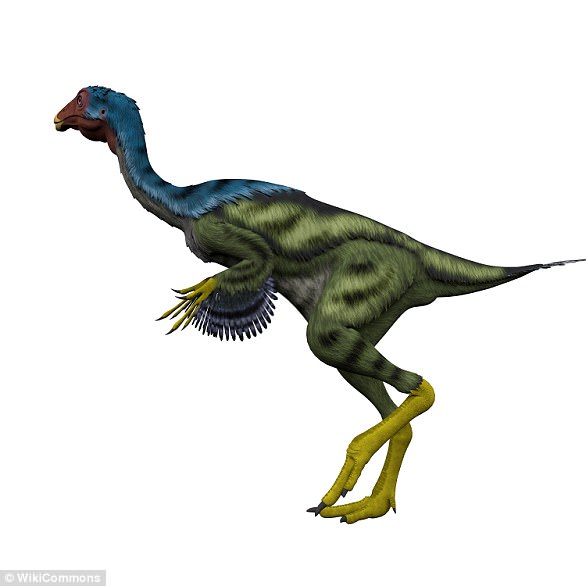Oklahoma student discovers new dinosaur species while examining fossils he purchased for a class project
A graduate student who bought $5,000 worth of dinosaur bones from a private dealer for school can now claim the rare honor of discovering a new species.
Kyle Atkins-Weltman, now a PhD candidate in ‘paleoecology’ at Oklahoma State University, was even allowed to name his find.
He called it the ‘Pharaoh’s dawn chicken from hell’ (Eoneophron infernalis in Latin).
But this ‘chicken from hell’ – a smaller cousin of the previously famous and also very fowl-like dinosaur, Anzu wylieiwhose bones Atkins-Weltman thought he bought – actually has a much bigger story to tell than just its own existence.
“Our work,” the PhD student argued, “shows that dinosaur diversity may not have decreased before the asteroid hit.”
In other words, his new species runs counter to theories repeatedly advanced by other paleontologists who claim that the dinosaurs were already becoming extinct, weakened by repeated “volcanic winters” before the Chicxulub meteor delivered its death blow.
Above is an illustration of the new ‘chicken from hell’ – a smaller cousin of the previously famous and very fowl-like dinosaur, ‘Anzu wyliei.’ The new species has been dubbed the ‘Pharaoh’s dawn chicken from hell’ (‘Eoneophron infernalis’ in Latin) by the 28-year-old who discovered it
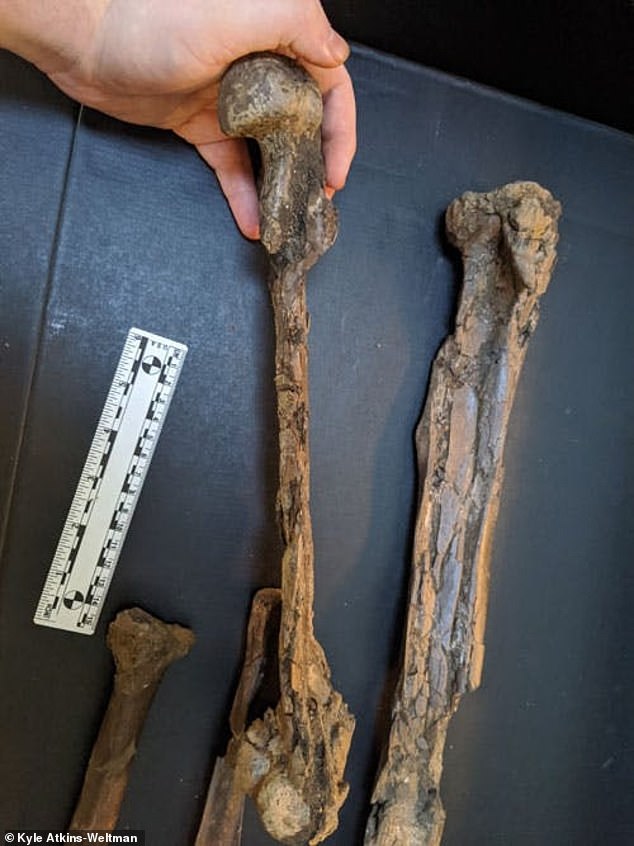
Kyle Atkins-Weltman, now a doctoral candidate in “paleoecology” at Oklahoma State University, bought $5,000 worth of dinosaur bones from a private dealer for a school project when he was a graduate student in Kansas. Those bones turned out to be a brand new species of dinosaur
Working with Dr. Eric Snively, an associate professor of anatomy at Oklahoma State, the young Atkins-Weltman now believes that even more undiscovered dinosaurs from the final years of the Cretaceous period may be right under researchers’ noses.
“More species from this period remain to be discovered,” the pair wrote The conversation‘possibly even by reclassifying fossils already in museum collections.’
Their reasoning is based on methods used to confirm that Eoneophron infernalis is truly a new species: paleohistology, the study of microstructures in fossil bone.
Paleohistological techniques underwent a revolution in the second half of the 20th century, suggesting that about a century of early dinosaur discoveries could still benefit from a more modern and detailed second look.
In the case of the new ‘Pharaoh’s Dawn Chicken from Hell’, the truth came from taking thin slices of the bones and determining the age like the rings of a tree.
Atkins-Weltman had originally purchased the fossils during a graduate program at the University of Kansas – hoping to reveal the weight-bearing or “metatarsal” toe bones of the Anzu ‘Hell Chicken’ dinosaur.
The PhD student thought he had ordered femurs, tibias and metatarsals from the Anzu wylieia larger example of the same Oviraptorosaur (‘egg thief lizard’) group of dinosaurs as the new species.
But something was wrong with the bones.
‘They were about 25 percent smaller than others Anzu fossils,” Atkins-Weltman recalled.
‘We thought it was a juvenile Anzuhe told Oklahoma State’s alumni magazine.
‘I assumed it was a Anzuuntil the evidence showed otherwise.”
Help from Dr. Holly Woodward-Ballard, an associate professor of anatomy from Oklahoma State, revealed that the distances between the outer rings of this specimen’s bone slices were too tightly packed to be the bones of a juvenile. Anzu.
The ringed lay in the bones of a young animal, as Woodward-Ballard explained the Washington Postare often far apart – a sign of youthful growth spurts.
However, the rings in the Atkins-Weltman fossil purchase were so close together that Dr. Woodward believed they suggested a dinosaur near its prime.
Or, as she put it under local KWTV News 9: ‘I’d say this creature is almost fully grown.’
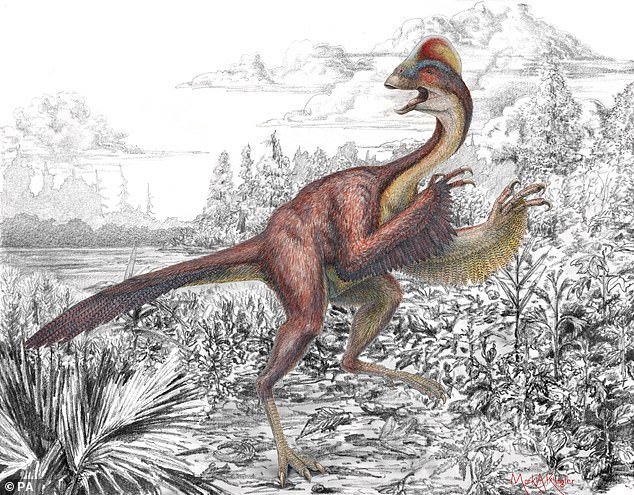
The 3-meter-tall ‘Anzu wyliei’ creature (pictured above) was discovered in 2014 and was named because of a chicken-like crest on its head, feathered wings, long claws and dangerous beak
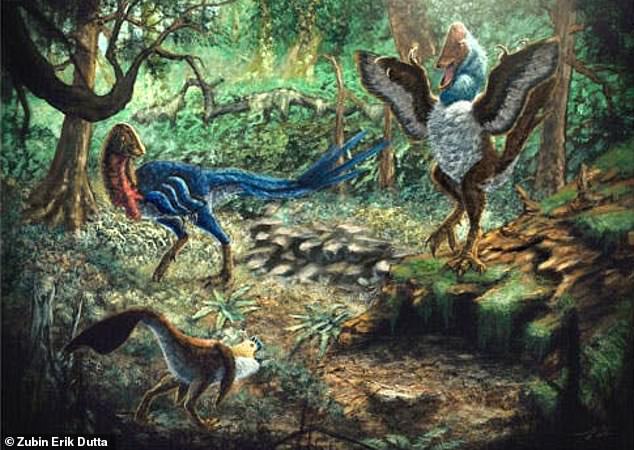
In 2014, University of Utah paleontologists discovered three partial skeletons of ‘Anzu wyliei’ in ancient rocks in North and South Dakota. It was fossils purchased from digs in the same general area – the Hell Creek Formation – that led to the new species of ‘hell chicken’
Atkins-Weltman, Dr. Snively, Dr. Woodward-Ballard and their colleagues published news about the new dinosaur in the magazine PLOS One this January.
The bones were unearthed in the so-called Hell Creek Formation, an area spanning Montana, North Dakota, South Dakota and Wyoming, where many dinosaur fossils – including the 10-foot tall Anzu wyliei ‘Hell Chicken’ – had been discovered.
Atkins-Weltman’s new cousin of that ‘hell chicken’ Eoneophron infernalismeasuring less than a third that size: about three feet tall at the hip, and about the weight of a human, between 150 and 160 pounds.
The 28-year-old PhD student chose the name ‘Pharaoh’s Dawn Chicken from Hell’, in honor of both Anzu and his own deceased pet Pharaoh, a Nile monitor.
‘It was a very bird-like dinosaur. It had a toothless beak and a relatively short tail. It is difficult to determine its diet because of the toothless beak,” Atkins-Weltman said.
“It definitely had feathers,” he added. “It was covered in feathers and had wings.”
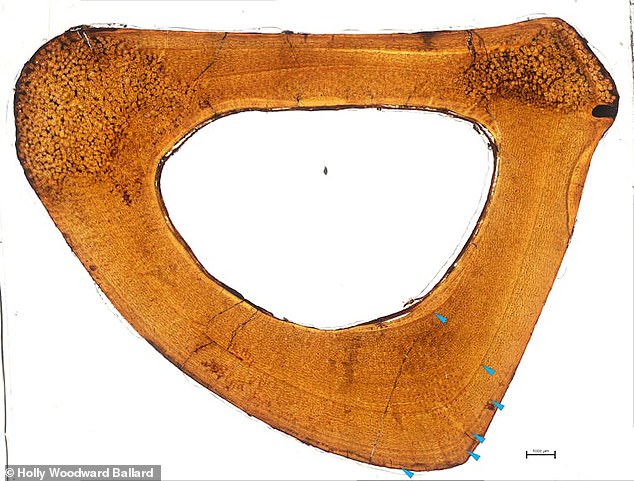
Help from Dr. Holly Woodward-Ballard, an associate professor of anatomy from Oklahoma State, revealed that the distances between the outer rings of the bone slices of the new specimen (above) were too tightly packed to be bone from a juvenile ‘Anzu wyliei’ – indicating a new ‘hell’. chicken’
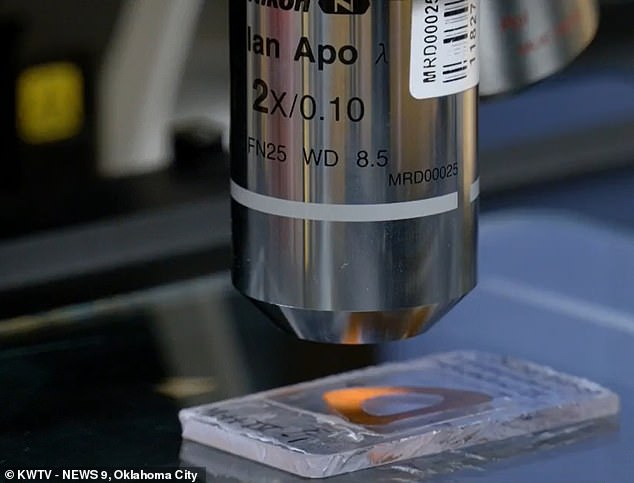
The ringed layers in a young animal’s bones, as Woodward-Ballard explained it, are normally far apart – a sign of its youthful growth spurts and rapid maturation. Above, a thin slice of bone from the new species under a microscope for paleohistological analysis
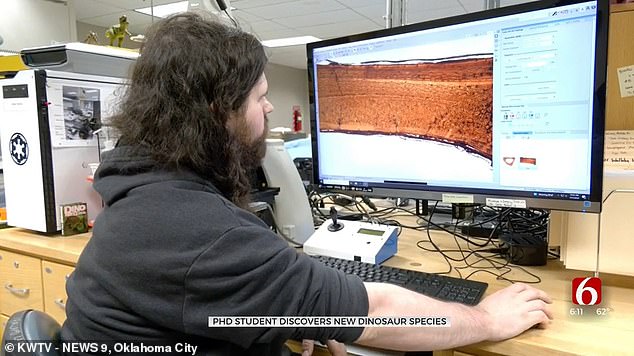
Atkins-Weltman (above) looks intently at a piece of his new ‘hell chicken’ dinosaur for cameramen on a local TV news crew
Atkins-Weltman told the Washington Post that the discovery surprised him.
“It took me maybe at least two or three days to really think about that because it was so serendipitous,” he said. ‘It didn’t start with a ‘eureka’, but with a ‘Hmm, that’s strange.’
Oklahoma State doctoral candidate Atkins-Weltman studies vertebrate anatomy and paleontology. According to the school, he is the first of its students to ever have the discovery of a new dinosaur published in a peer-reviewed journal.
“My heart jumped because I never expected something like this to fall into my lap,” he admitted. “This is what I want to do for the rest of my life.”

